Annotated Bibliography for Productive Construction Project Analysis
VerifiedAdded on 2022/08/29
|6
|1628
|17
Annotated Bibliography
AI Summary
This annotated bibliography examines various research papers and articles related to productive construction projects. The bibliography covers a wide range of topics, including pre-construction practices, core competencies, and the impact of construction delays on project delivery. It also delves into the importance of benchmarks, the role of project management information systems, and the relationship between pre-construction decision-making and risk control. Furthermore, it explores the application of optimal bid models, sustainable innovation, and the use of construction technologies. The articles highlight the significance of effective site management, the reduction of construction delays, and the enhancement of productivity, quality control, and safety within the construction industry. This annotated bibliography provides valuable insights into the challenges and opportunities in optimizing construction project outcomes and efficiency.
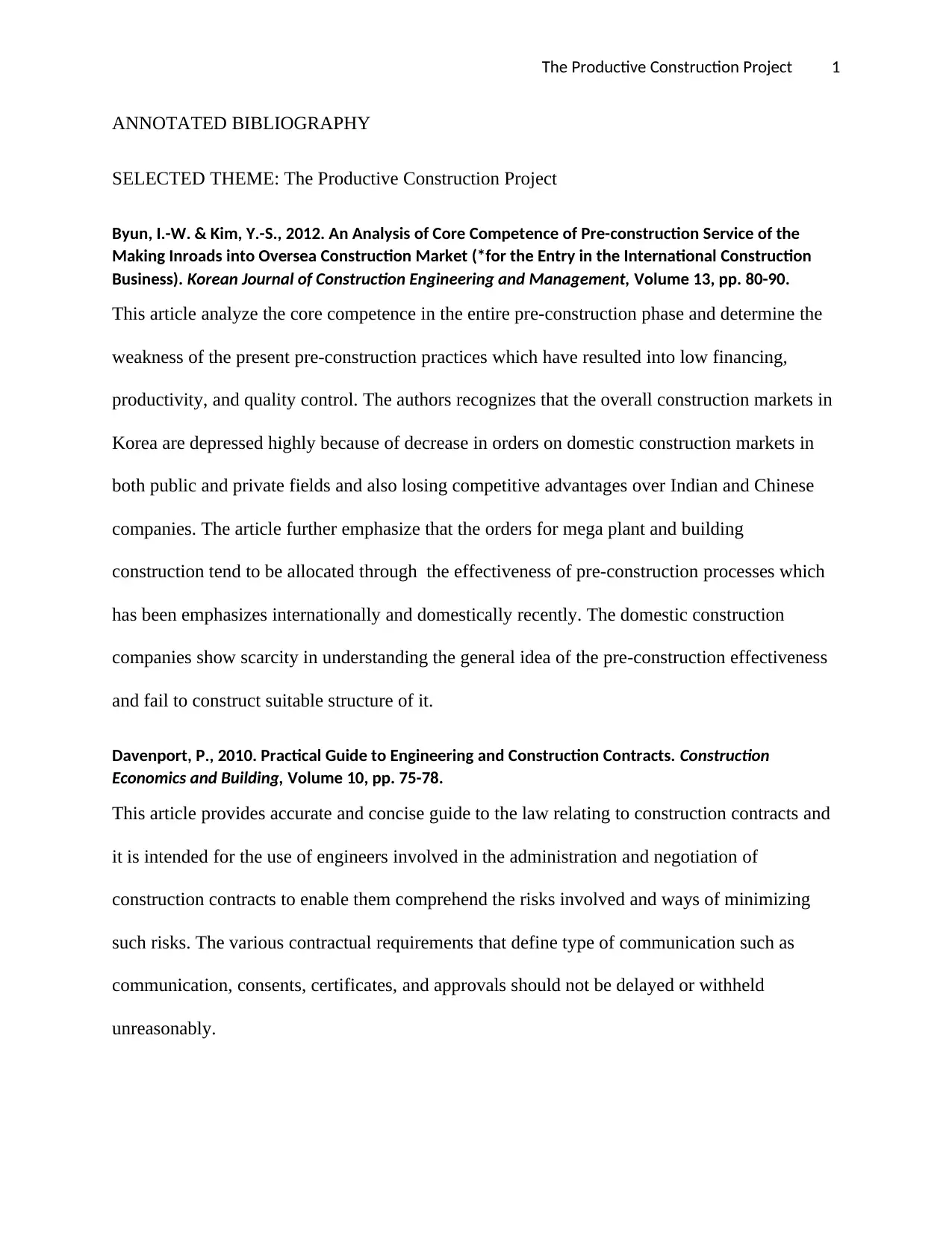
The Productive Construction Project 1
ANNOTATED BIBLIOGRAPHY
SELECTED THEME: The Productive Construction Project
Byun, I.-W. & Kim, Y.-S., 2012. An Analysis of Core Competence of Pre-construction Service of the
Making Inroads into Oversea Construction Market (*for the Entry in the International Construction
Business). Korean Journal of Construction Engineering and Management, Volume 13, pp. 80-90.
This article analyze the core competence in the entire pre-construction phase and determine the
weakness of the present pre-construction practices which have resulted into low financing,
productivity, and quality control. The authors recognizes that the overall construction markets in
Korea are depressed highly because of decrease in orders on domestic construction markets in
both public and private fields and also losing competitive advantages over Indian and Chinese
companies. The article further emphasize that the orders for mega plant and building
construction tend to be allocated through the effectiveness of pre-construction processes which
has been emphasizes internationally and domestically recently. The domestic construction
companies show scarcity in understanding the general idea of the pre-construction effectiveness
and fail to construct suitable structure of it.
Davenport, P., 2010. Practical Guide to Engineering and Construction Contracts. Construction
Economics and Building, Volume 10, pp. 75-78.
This article provides accurate and concise guide to the law relating to construction contracts and
it is intended for the use of engineers involved in the administration and negotiation of
construction contracts to enable them comprehend the risks involved and ways of minimizing
such risks. The various contractual requirements that define type of communication such as
communication, consents, certificates, and approvals should not be delayed or withheld
unreasonably.
ANNOTATED BIBLIOGRAPHY
SELECTED THEME: The Productive Construction Project
Byun, I.-W. & Kim, Y.-S., 2012. An Analysis of Core Competence of Pre-construction Service of the
Making Inroads into Oversea Construction Market (*for the Entry in the International Construction
Business). Korean Journal of Construction Engineering and Management, Volume 13, pp. 80-90.
This article analyze the core competence in the entire pre-construction phase and determine the
weakness of the present pre-construction practices which have resulted into low financing,
productivity, and quality control. The authors recognizes that the overall construction markets in
Korea are depressed highly because of decrease in orders on domestic construction markets in
both public and private fields and also losing competitive advantages over Indian and Chinese
companies. The article further emphasize that the orders for mega plant and building
construction tend to be allocated through the effectiveness of pre-construction processes which
has been emphasizes internationally and domestically recently. The domestic construction
companies show scarcity in understanding the general idea of the pre-construction effectiveness
and fail to construct suitable structure of it.
Davenport, P., 2010. Practical Guide to Engineering and Construction Contracts. Construction
Economics and Building, Volume 10, pp. 75-78.
This article provides accurate and concise guide to the law relating to construction contracts and
it is intended for the use of engineers involved in the administration and negotiation of
construction contracts to enable them comprehend the risks involved and ways of minimizing
such risks. The various contractual requirements that define type of communication such as
communication, consents, certificates, and approvals should not be delayed or withheld
unreasonably.
Paraphrase This Document
Need a fresh take? Get an instant paraphrase of this document with our AI Paraphraser

The Productive Construction Project 2
Dykes, C. & Baird, G., 2013. Performance benchmarks for non-domestic buildings: towards user
perception benchmarks. Building Research & Information, Volume 42, pp. 62-71.
This article illustrates the importance of benchmarks in construction since indoor environments
can affect the perception of occupants of their productivity, health, and comfort productivity in
buildings. In case the perceptions of users of building performance are to be improved and
addresses, then it is significant to have standardized and reliable set of benchmarks against which
to determine them. The data from benchmarks in construction enables demonstration of systems
that can be internationally replicated and exploration of the construction potential benchmarks. It
is feasible to determine benchmarks from questionnaire including noise, comfort, productivity,
and lighting.
Gandhak, P. & Sabihuddin, S., 2014. Stakeholders' Perception of the Causes and Effect of Construction
Delays on Project Delivery-A Review. Journal of Construction Engineering and Project Management,
Volume 4, pp. 41-46.
The article identifies the causes and effects of construction delays on project delivery according
to the perceptions of the stakeholders so as to promote productivity, social responsibility, and
cost reduction. A unique element of risk in the construction industry is the way in which claims
and disputes are solved through the channel of the construction process. Delay is normally
recognized as the most risky, complex, costly, and common problem encountered in the
construction projects. It is the source of frequent claims and disputes leading to lawsuits because
of the overriding significance of time for both the contractor and the owner. The article primarily
identify the method of reducing the construction delays, the types of delays, the allocation of
responsibilities, and the perceptions of the different parties concerning causes of delays.
Dykes, C. & Baird, G., 2013. Performance benchmarks for non-domestic buildings: towards user
perception benchmarks. Building Research & Information, Volume 42, pp. 62-71.
This article illustrates the importance of benchmarks in construction since indoor environments
can affect the perception of occupants of their productivity, health, and comfort productivity in
buildings. In case the perceptions of users of building performance are to be improved and
addresses, then it is significant to have standardized and reliable set of benchmarks against which
to determine them. The data from benchmarks in construction enables demonstration of systems
that can be internationally replicated and exploration of the construction potential benchmarks. It
is feasible to determine benchmarks from questionnaire including noise, comfort, productivity,
and lighting.
Gandhak, P. & Sabihuddin, S., 2014. Stakeholders' Perception of the Causes and Effect of Construction
Delays on Project Delivery-A Review. Journal of Construction Engineering and Project Management,
Volume 4, pp. 41-46.
The article identifies the causes and effects of construction delays on project delivery according
to the perceptions of the stakeholders so as to promote productivity, social responsibility, and
cost reduction. A unique element of risk in the construction industry is the way in which claims
and disputes are solved through the channel of the construction process. Delay is normally
recognized as the most risky, complex, costly, and common problem encountered in the
construction projects. It is the source of frequent claims and disputes leading to lawsuits because
of the overriding significance of time for both the contractor and the owner. The article primarily
identify the method of reducing the construction delays, the types of delays, the allocation of
responsibilities, and the perceptions of the different parties concerning causes of delays.
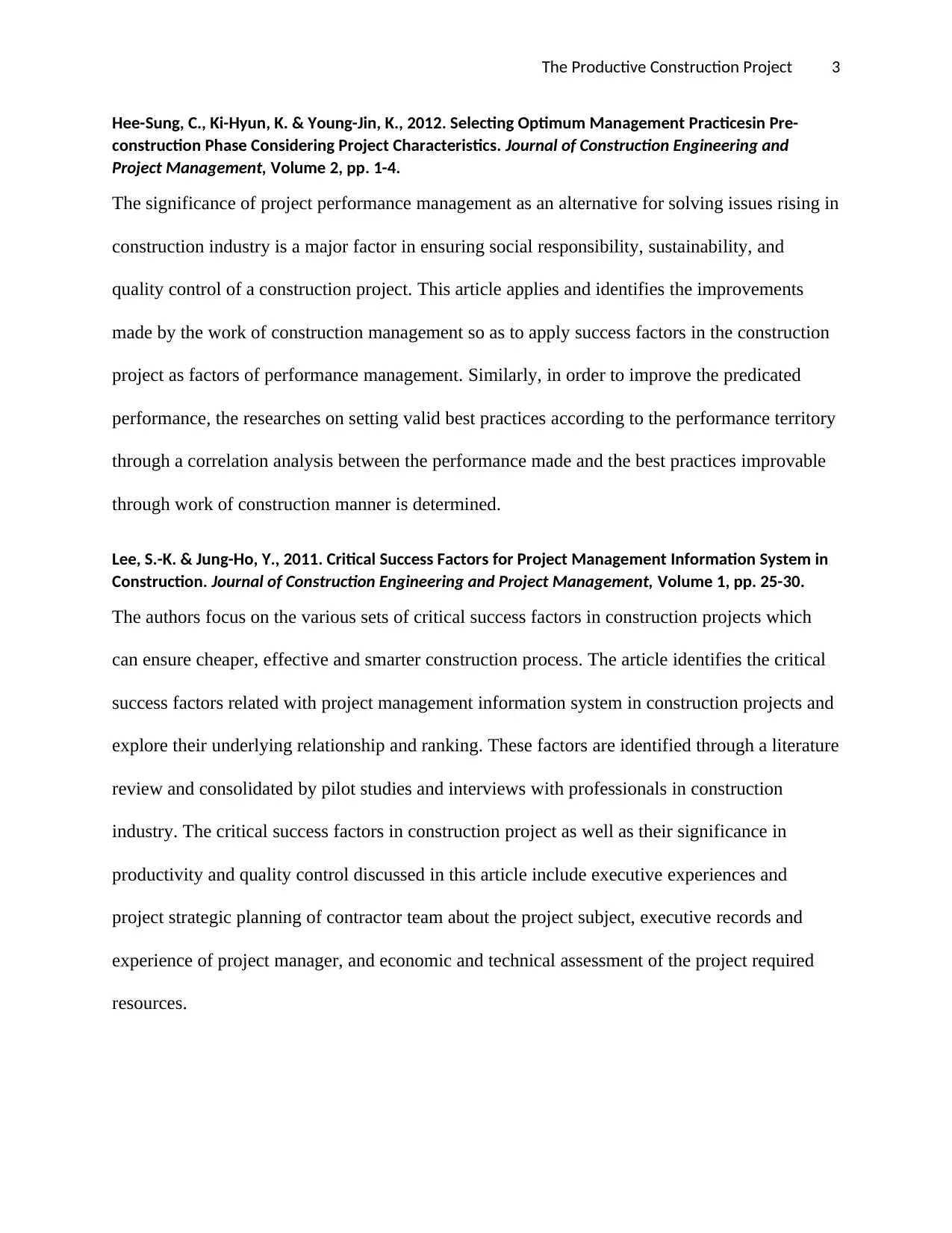
The Productive Construction Project 3
Hee-Sung, C., Ki-Hyun, K. & Young-Jin, K., 2012. Selecting Optimum Management Practicesin Pre-
construction Phase Considering Project Characteristics. Journal of Construction Engineering and
Project Management, Volume 2, pp. 1-4.
The significance of project performance management as an alternative for solving issues rising in
construction industry is a major factor in ensuring social responsibility, sustainability, and
quality control of a construction project. This article applies and identifies the improvements
made by the work of construction management so as to apply success factors in the construction
project as factors of performance management. Similarly, in order to improve the predicated
performance, the researches on setting valid best practices according to the performance territory
through a correlation analysis between the performance made and the best practices improvable
through work of construction manner is determined.
Lee, S.-K. & Jung-Ho, Y., 2011. Critical Success Factors for Project Management Information System in
Construction. Journal of Construction Engineering and Project Management, Volume 1, pp. 25-30.
The authors focus on the various sets of critical success factors in construction projects which
can ensure cheaper, effective and smarter construction process. The article identifies the critical
success factors related with project management information system in construction projects and
explore their underlying relationship and ranking. These factors are identified through a literature
review and consolidated by pilot studies and interviews with professionals in construction
industry. The critical success factors in construction project as well as their significance in
productivity and quality control discussed in this article include executive experiences and
project strategic planning of contractor team about the project subject, executive records and
experience of project manager, and economic and technical assessment of the project required
resources.
Hee-Sung, C., Ki-Hyun, K. & Young-Jin, K., 2012. Selecting Optimum Management Practicesin Pre-
construction Phase Considering Project Characteristics. Journal of Construction Engineering and
Project Management, Volume 2, pp. 1-4.
The significance of project performance management as an alternative for solving issues rising in
construction industry is a major factor in ensuring social responsibility, sustainability, and
quality control of a construction project. This article applies and identifies the improvements
made by the work of construction management so as to apply success factors in the construction
project as factors of performance management. Similarly, in order to improve the predicated
performance, the researches on setting valid best practices according to the performance territory
through a correlation analysis between the performance made and the best practices improvable
through work of construction manner is determined.
Lee, S.-K. & Jung-Ho, Y., 2011. Critical Success Factors for Project Management Information System in
Construction. Journal of Construction Engineering and Project Management, Volume 1, pp. 25-30.
The authors focus on the various sets of critical success factors in construction projects which
can ensure cheaper, effective and smarter construction process. The article identifies the critical
success factors related with project management information system in construction projects and
explore their underlying relationship and ranking. These factors are identified through a literature
review and consolidated by pilot studies and interviews with professionals in construction
industry. The critical success factors in construction project as well as their significance in
productivity and quality control discussed in this article include executive experiences and
project strategic planning of contractor team about the project subject, executive records and
experience of project manager, and economic and technical assessment of the project required
resources.
⊘ This is a preview!⊘
Do you want full access?
Subscribe today to unlock all pages.

Trusted by 1+ million students worldwide
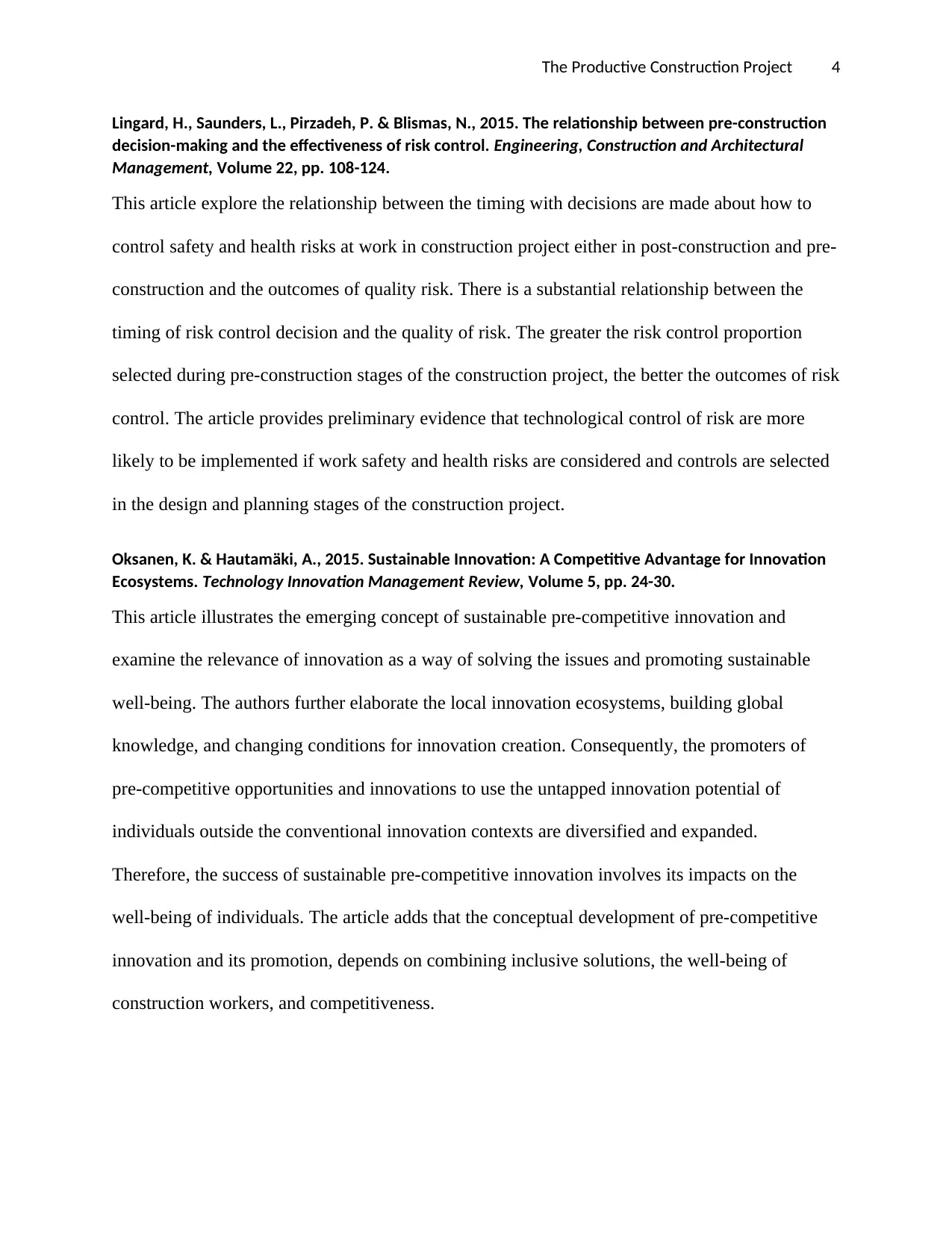
The Productive Construction Project 4
Lingard, H., Saunders, L., Pirzadeh, P. & Blismas, N., 2015. The relationship between pre-construction
decision-making and the effectiveness of risk control. Engineering, Construction and Architectural
Management, Volume 22, pp. 108-124.
This article explore the relationship between the timing with decisions are made about how to
control safety and health risks at work in construction project either in post-construction and pre-
construction and the outcomes of quality risk. There is a substantial relationship between the
timing of risk control decision and the quality of risk. The greater the risk control proportion
selected during pre-construction stages of the construction project, the better the outcomes of risk
control. The article provides preliminary evidence that technological control of risk are more
likely to be implemented if work safety and health risks are considered and controls are selected
in the design and planning stages of the construction project.
Oksanen, K. & Hautamäki, A., 2015. Sustainable Innovation: A Competitive Advantage for Innovation
Ecosystems. Technology Innovation Management Review, Volume 5, pp. 24-30.
This article illustrates the emerging concept of sustainable pre-competitive innovation and
examine the relevance of innovation as a way of solving the issues and promoting sustainable
well-being. The authors further elaborate the local innovation ecosystems, building global
knowledge, and changing conditions for innovation creation. Consequently, the promoters of
pre-competitive opportunities and innovations to use the untapped innovation potential of
individuals outside the conventional innovation contexts are diversified and expanded.
Therefore, the success of sustainable pre-competitive innovation involves its impacts on the
well-being of individuals. The article adds that the conceptual development of pre-competitive
innovation and its promotion, depends on combining inclusive solutions, the well-being of
construction workers, and competitiveness.
Lingard, H., Saunders, L., Pirzadeh, P. & Blismas, N., 2015. The relationship between pre-construction
decision-making and the effectiveness of risk control. Engineering, Construction and Architectural
Management, Volume 22, pp. 108-124.
This article explore the relationship between the timing with decisions are made about how to
control safety and health risks at work in construction project either in post-construction and pre-
construction and the outcomes of quality risk. There is a substantial relationship between the
timing of risk control decision and the quality of risk. The greater the risk control proportion
selected during pre-construction stages of the construction project, the better the outcomes of risk
control. The article provides preliminary evidence that technological control of risk are more
likely to be implemented if work safety and health risks are considered and controls are selected
in the design and planning stages of the construction project.
Oksanen, K. & Hautamäki, A., 2015. Sustainable Innovation: A Competitive Advantage for Innovation
Ecosystems. Technology Innovation Management Review, Volume 5, pp. 24-30.
This article illustrates the emerging concept of sustainable pre-competitive innovation and
examine the relevance of innovation as a way of solving the issues and promoting sustainable
well-being. The authors further elaborate the local innovation ecosystems, building global
knowledge, and changing conditions for innovation creation. Consequently, the promoters of
pre-competitive opportunities and innovations to use the untapped innovation potential of
individuals outside the conventional innovation contexts are diversified and expanded.
Therefore, the success of sustainable pre-competitive innovation involves its impacts on the
well-being of individuals. The article adds that the conceptual development of pre-competitive
innovation and its promotion, depends on combining inclusive solutions, the well-being of
construction workers, and competitiveness.
Paraphrase This Document
Need a fresh take? Get an instant paraphrase of this document with our AI Paraphraser
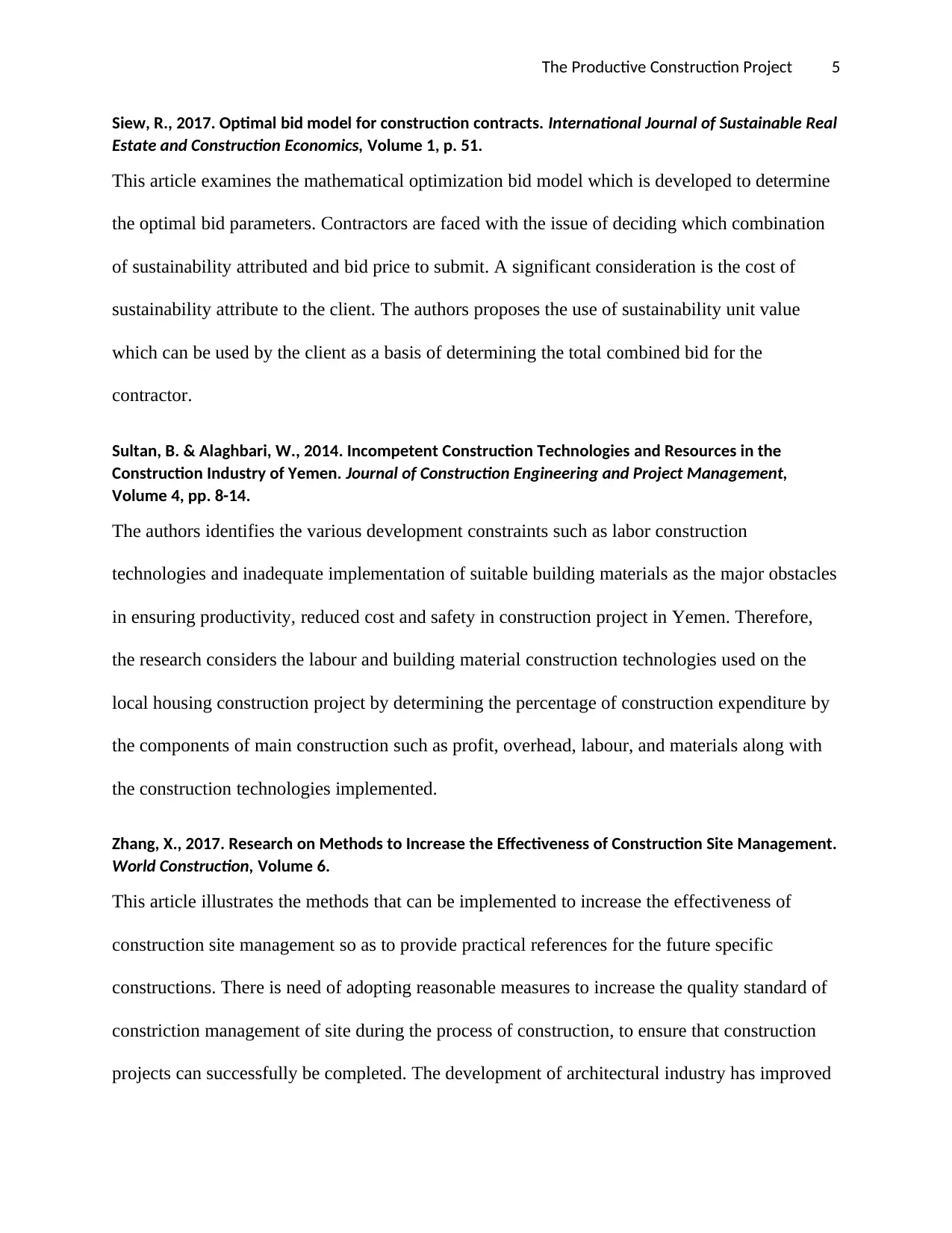
The Productive Construction Project 5
Siew, R., 2017. Optimal bid model for construction contracts. International Journal of Sustainable Real
Estate and Construction Economics, Volume 1, p. 51.
This article examines the mathematical optimization bid model which is developed to determine
the optimal bid parameters. Contractors are faced with the issue of deciding which combination
of sustainability attributed and bid price to submit. A significant consideration is the cost of
sustainability attribute to the client. The authors proposes the use of sustainability unit value
which can be used by the client as a basis of determining the total combined bid for the
contractor.
Sultan, B. & Alaghbari, W., 2014. Incompetent Construction Technologies and Resources in the
Construction Industry of Yemen. Journal of Construction Engineering and Project Management,
Volume 4, pp. 8-14.
The authors identifies the various development constraints such as labor construction
technologies and inadequate implementation of suitable building materials as the major obstacles
in ensuring productivity, reduced cost and safety in construction project in Yemen. Therefore,
the research considers the labour and building material construction technologies used on the
local housing construction project by determining the percentage of construction expenditure by
the components of main construction such as profit, overhead, labour, and materials along with
the construction technologies implemented.
Zhang, X., 2017. Research on Methods to Increase the Effectiveness of Construction Site Management.
World Construction, Volume 6.
This article illustrates the methods that can be implemented to increase the effectiveness of
construction site management so as to provide practical references for the future specific
constructions. There is need of adopting reasonable measures to increase the quality standard of
constriction management of site during the process of construction, to ensure that construction
projects can successfully be completed. The development of architectural industry has improved
Siew, R., 2017. Optimal bid model for construction contracts. International Journal of Sustainable Real
Estate and Construction Economics, Volume 1, p. 51.
This article examines the mathematical optimization bid model which is developed to determine
the optimal bid parameters. Contractors are faced with the issue of deciding which combination
of sustainability attributed and bid price to submit. A significant consideration is the cost of
sustainability attribute to the client. The authors proposes the use of sustainability unit value
which can be used by the client as a basis of determining the total combined bid for the
contractor.
Sultan, B. & Alaghbari, W., 2014. Incompetent Construction Technologies and Resources in the
Construction Industry of Yemen. Journal of Construction Engineering and Project Management,
Volume 4, pp. 8-14.
The authors identifies the various development constraints such as labor construction
technologies and inadequate implementation of suitable building materials as the major obstacles
in ensuring productivity, reduced cost and safety in construction project in Yemen. Therefore,
the research considers the labour and building material construction technologies used on the
local housing construction project by determining the percentage of construction expenditure by
the components of main construction such as profit, overhead, labour, and materials along with
the construction technologies implemented.
Zhang, X., 2017. Research on Methods to Increase the Effectiveness of Construction Site Management.
World Construction, Volume 6.
This article illustrates the methods that can be implemented to increase the effectiveness of
construction site management so as to provide practical references for the future specific
constructions. There is need of adopting reasonable measures to increase the quality standard of
constriction management of site during the process of construction, to ensure that construction
projects can successfully be completed. The development of architectural industry has improved
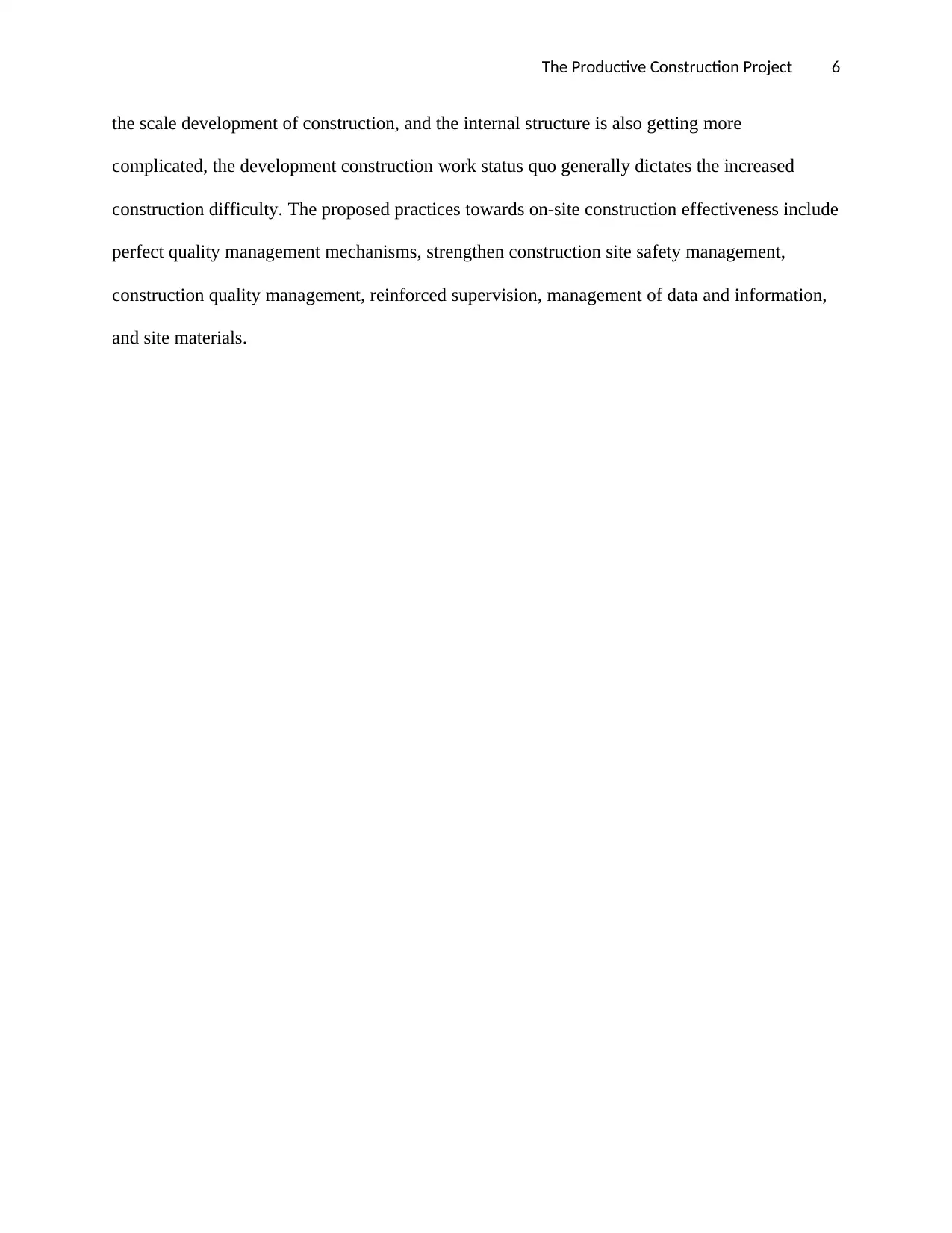
The Productive Construction Project 6
the scale development of construction, and the internal structure is also getting more
complicated, the development construction work status quo generally dictates the increased
construction difficulty. The proposed practices towards on-site construction effectiveness include
perfect quality management mechanisms, strengthen construction site safety management,
construction quality management, reinforced supervision, management of data and information,
and site materials.
the scale development of construction, and the internal structure is also getting more
complicated, the development construction work status quo generally dictates the increased
construction difficulty. The proposed practices towards on-site construction effectiveness include
perfect quality management mechanisms, strengthen construction site safety management,
construction quality management, reinforced supervision, management of data and information,
and site materials.
⊘ This is a preview!⊘
Do you want full access?
Subscribe today to unlock all pages.

Trusted by 1+ million students worldwide
1 out of 6
Your All-in-One AI-Powered Toolkit for Academic Success.
+13062052269
info@desklib.com
Available 24*7 on WhatsApp / Email
![[object Object]](/_next/static/media/star-bottom.7253800d.svg)
Unlock your academic potential
Copyright © 2020–2025 A2Z Services. All Rights Reserved. Developed and managed by ZUCOL.